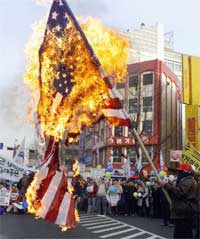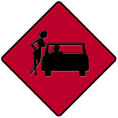Part 4: Cases and Arguments
American Booksellers Association v. Hudnut (1985)
WEBLINK: Click here to read American Booksellers Association v. Hudnut.
This case involved an Indianapolis ordinance which was motivated by the belief that pornography served to, and promoted, discrimination against women. The ordinance was based in large part on the arguments offered by Katherine MacKinnon. The ordinance defined pornography as "the graphic sexually explicit subordination of women," whether in pictures or in words, that also includes one or more of the following:
- Women are presented as sexual objects who enjoy pain or humiliation; or
- Women are presented as sexual objects who experience sexual pleasure in being raped; or
- Women are presented as sexual objects tied up or cut up or mutilated or bruised or physically hurt, or as dismembered or truncated or fragmented or severed into body parts; or
- Women are presented as being penetrated by objects or animals; or
- Women are presented in scenarios of degradation, injury, abasement, torture, shown as filthy or inferior, bleeding, bruised, or hurt in a context that makes these conditions sexual; or
- Women are presented as sexual objects for domination, conquest, violation, exploitation, possession, or use, or through postures or positions of servility or submission or display.
Defenders of this ordinance argued that the ordinance focuses on pornography's role in increasing discrimination in the workplace, sexism in daily life, and violence against women. However, the court ruled that  this ordinance is a content limitation on speech, as such the state cannot rule one view right (women's equality is violated by porn) and silence the opposition (violent porn).
this ordinance is a content limitation on speech, as such the state cannot rule one view right (women's equality is violated by porn) and silence the opposition (violent porn).
How would this ordinance impact classic literature or film? The court ruled that this was a restriction upon speech and not upon the conduct of porn production. This may be justified if the case was made that the state has a compelling interest in reducing discrimination, but evidence of this was not established.
Thought Question: Criminalizing harmful media?
What would it mean if we could criminalize speech, film, books, etc. if we could show that they did in fact cause harm in society? What sorts of things might fall under this category? Would this restriction pass the "content vs. method" test? Should we adopt such a view?
The following is a synopsis of two articles by Joel Feinberg concerning pornography and offense.
Feinberg: Pornography, Feminism, and Liberalism
Traditional opponents of porn were sexual conservatives who morally objected to the pursuit of sexual pleasure for its own sake. They argued that pornography corrupted character (promoted vice, not virtue). Now liberal feminists argue that pornography is a harm to women mainly for its effect upon the behaviors and attitudes of men. This objection in itself yields the unstated conclusion that pornography is not the offender, but that a specific element of pornography is. This conclusion is often evident when liberal feminists make a distinction between erotica (sexual material that is not thought to harm women-the married couple having sex on camera) and "pornography" (sexual material that is harmful to women as depicted in the Indiana law).
 Even "pornography" as feminists define it Feinberg finds is not about hostility towards women at all. The nature of fantasy is about over-glorifying the person doing the fantasizing. In romance novels, this means lovesick men worshiping the ground that the woman walks upon. In pornography this means women worshiping a man and his sexual talents, wanting to do anything to please him. We do not find the former degrading to men, nor should we find the second degrading to women. There exists both violent pornography, violent/harmful sexual acts or discriminations towards women, and the "cult of macho" male attitude that liberal feminists are against. Now, what is the relationship between these three things?
Even "pornography" as feminists define it Feinberg finds is not about hostility towards women at all. The nature of fantasy is about over-glorifying the person doing the fantasizing. In romance novels, this means lovesick men worshiping the ground that the woman walks upon. In pornography this means women worshiping a man and his sexual talents, wanting to do anything to please him. We do not find the former degrading to men, nor should we find the second degrading to women. There exists both violent pornography, violent/harmful sexual acts or discriminations towards women, and the "cult of macho" male attitude that liberal feminists are against. Now, what is the relationship between these three things?
According to liberal feminists, it looks like this:
Violent pornography gives rise to ![]() the cult of macho which in turn causes
the cult of macho which in turn causes ![]() violent/harmful sexual acts or discriminations against women
violent/harmful sexual acts or discriminations against women
This picture is inadequate as there is no proven causation between the existence of violent pornography and sexual violence or discrimination against women. Also, men who commit these acts or have the "cult of macho" attitude did not get it from violent or degrading pornography. Those who possess the cult of macho tend to consume violent pornography and tend to commit violence/discriminations against women. Feinberg thus paints the relationship as follows:
The cult of macho ![]() creates a market for violent porn.
creates a market for violent porn.
The cult of macho ![]() leads to violence or discrimination against women.
leads to violence or discrimination against women.
 Notice, in this account, the existence of violent porn is not linked to violence or discrimination against women. Instead, both are caused by the cult of macho. Therefore, banning violent porn seems ineffectual. Feinberg's picture is one in which the cult of macho is a predisposition or preexisting event rather than one that is caused by porn. In other words, watching porn can't make you like violent porn and thereby commit violence or discrimination against women. Rather, those with the cult of macho will like violent porn and will tend to commit violence or discrimination against women. The real culprit on Feinberg's account is the cult of macho, which is cultural in nature. To combat it, education is necessary. Criminalizing pornography will not accomplish the goal the liberal feminist desires. Even if some pornography does lead some people to act improperly, this is not a justification to criminalize it any more than, as Mill mentioned, a drunk who gets violent justifies criminalizing alcohol. Most viewers of porn, even violent porn, do not cause harm to others, and therefore no criminal justification is warranted.
Notice, in this account, the existence of violent porn is not linked to violence or discrimination against women. Instead, both are caused by the cult of macho. Therefore, banning violent porn seems ineffectual. Feinberg's picture is one in which the cult of macho is a predisposition or preexisting event rather than one that is caused by porn. In other words, watching porn can't make you like violent porn and thereby commit violence or discrimination against women. Rather, those with the cult of macho will like violent porn and will tend to commit violence or discrimination against women. The real culprit on Feinberg's account is the cult of macho, which is cultural in nature. To combat it, education is necessary. Criminalizing pornography will not accomplish the goal the liberal feminist desires. Even if some pornography does lead some people to act improperly, this is not a justification to criminalize it any more than, as Mill mentioned, a drunk who gets violent justifies criminalizing alcohol. Most viewers of porn, even violent porn, do not cause harm to others, and therefore no criminal justification is warranted.
Further, in traditional law, if A gives B information knowing and intending B to use that information in a crime  against C, then A's actions were criminal. For instance, if A gives B information on how to make a bomb, knowing and intending that B use the bomb to kill C, then A's actions were part of the criminal conspiracy. However, if A gave information to B without knowing or intending B to use it in a crime, then we do not hold A's actions criminal. For instance, if A publishes a book on how to make bombs (say, to demolish old buildings or clear land for construction) and B uses that book to blow up C, we do not hold A's actions criminal. The same is true for pornography. Even if some people commit copycat crimes after watching violent pornography, this would not be enough to say the manufacturers of the pornography's actions were criminal as they had neither knowledge nor intent of the crime.
against C, then A's actions were criminal. For instance, if A gives B information on how to make a bomb, knowing and intending that B use the bomb to kill C, then A's actions were part of the criminal conspiracy. However, if A gave information to B without knowing or intending B to use it in a crime, then we do not hold A's actions criminal. For instance, if A publishes a book on how to make bombs (say, to demolish old buildings or clear land for construction) and B uses that book to blow up C, we do not hold A's actions criminal. The same is true for pornography. Even if some people commit copycat crimes after watching violent pornography, this would not be enough to say the manufacturers of the pornography's actions were criminal as they had neither knowledge nor intent of the crime.
In order to conclude that pornography incites harm, Feinberg mentions three conditions which must be the case:
- There must be strong evidence of a very likely and serious harm. [I would add-"that would not have occurred otherwise."]
- The harms must be clearly and directly linked with the expression.
- It must be unlikely that further speech or expression can be used effectively to combat the harm.
Not even violent pornography meets all three of these criteria. Therefore, it should not be criminalized due to inciting harm.
In the first article Feinberg argues against the position of MacKinnon and others that pornography incites a harm to women. In a second article Feinberg examines the possibly of restricting some pornography for a different reason. That reason is the profound offense some pornography causes. [ Note: some of this material was covered in module 3 but will be re-presented here ]
Joel Feinberg: The Offense Principle
Feinberg is generally in favor of Mill's harm principle and its protection of liberty. However, Feinberg thinks that we need an additional principle to regulate certain offensive actions. What is an offensive action? Feinberg describes offense as follows:
Passing annoyance, disappointment, disgust, embarrassment, and various other disliked
conditions such as fear, anxiety, and minor ("harmless") aches and pains, are not in
themselves necessarily harmful. Consequently, no matter how the harm principle is mediated, it
will not certify as legitimate those interferences with the liberty of some citizen that are made
for the sole purpose of preventing such unpleasant states in others. For convenience I will use
the word "offense" to cover the whole miscellany of universally disliked mental states. . .
Feinberg asks us to consider if Mill's harm principle was too limiting on society. Specifically, is society justified in restricting some behaviors that cause serious offense? Feinberg phrases such an offense principle as follows:
It is always a good reason in support of a proposed criminal prohibition that it would
probably be an effective way of preventing serious offense (as opposed to injury or harm) to
persons other than the actor, and that it is probably a necessary means to that end.
In other words, it is within society's legitimate power to regulate offensive conduct. Feinberg sets out three conditions for determining when offense has occurred.
- I suffer a disliked state, and
- I attribute that state to the wrongful conduct of another, and
- I resent the other person for his role in causing me to be in this state.
 Feinberg is not suggesting that all offensive acts must become matters of criminal law. Instead, he is suggesting that, under certain conditions, offensive acts can be so offensive as to morally justify a legal response such as a "cease and desist" order, license withdrawal, and injunction and fines against perpetrators of such behaviors. For instance, in module 3 it was discussed how Feinberg's offense principle would likely criminalize some, but not all, acts of flag burning. However, even when offensive acts become matters of criminal law, these actions do not seem likely to become matters of great punishment compared to actual harms. (Feinberg: don't think of "felony flag burning" as a likely charge; instead a misdemeanor seems in order.)
Feinberg is not suggesting that all offensive acts must become matters of criminal law. Instead, he is suggesting that, under certain conditions, offensive acts can be so offensive as to morally justify a legal response such as a "cease and desist" order, license withdrawal, and injunction and fines against perpetrators of such behaviors. For instance, in module 3 it was discussed how Feinberg's offense principle would likely criminalize some, but not all, acts of flag burning. However, even when offensive acts become matters of criminal law, these actions do not seem likely to become matters of great punishment compared to actual harms. (Feinberg: don't think of "felony flag burning" as a likely charge; instead a misdemeanor seems in order.)
Another One Rides the Bus
Feinberg presents several cases that involve offensive actions occurring on a public bus. I will offer variations of a handful of these cases to test your intuitions regarding the acceptability of offensive conduct.
 A man who has not bathed in over a month sits down next to you on a crowded bus. The stench is barely tolerable, and there is nowhere for you to go. Furthermore, the man seems to take a fancy to you such that he tries to sit next to you each day when possible.
A man who has not bathed in over a month sits down next to you on a crowded bus. The stench is barely tolerable, and there is nowhere for you to go. Furthermore, the man seems to take a fancy to you such that he tries to sit next to you each day when possible.
 A man rides the bus and sits in a seat across from you. During the ride he slips one hand down his pants and proceeds to masturbate while occasionally glancing and smiling at you. (Note: he remains completely clothed such that there is no "public exposure.")
A man rides the bus and sits in a seat across from you. During the ride he slips one hand down his pants and proceeds to masturbate while occasionally glancing and smiling at you. (Note: he remains completely clothed such that there is no "public exposure.")
 A group of foreign passengers enters the bus and begins to eat their lunch on the trip. Lunch consists of live insects, fish heads, and the pickled sex organs of lamb, all smothered in sauce. Afterwards they burp, fart, and then use an American flag to wipe their hands and mouths.
A group of foreign passengers enters the bus and begins to eat their lunch on the trip. Lunch consists of live insects, fish heads, and the pickled sex organs of lamb, all smothered in sauce. Afterwards they burp, fart, and then use an American flag to wipe their hands and mouths.
Each case is offensive; the question is, are any of these actions offensive to the point that we are justified in restricting the liberty of those who are doing them? It seems that Mill is forced to accept these actions as they do not harm others, only offend them. So, what sorts of offense are required for Feinberg's offense principle to justify a limitation on liberty? Feinberg says that we should take into account two sets of factors and balance them out.
The first set of standards is related to the reasonable avoidability of the offense :
- The intensity and duration of the offense as well as the anticipation of this
 reaction. (Do you know in advance that your action will cause offense of high intensity and long duration?)
reaction. (Do you know in advance that your action will cause offense of high intensity and long duration?)
- The ability of unwilling witnesses to avoid the display. (Did they sit and watch a full hour of an offensive TV show only to later claim offense or were they stuck in a room with the action without a way to avoid or withdraw from it?)
- Did the witnesses "assume the risk" of being offended? (Did you pay to enter a freak-show, for example?)
The above should be counter-balanced against the reasonableness of the offender's actions :
- The personal importance and social value of the action.
- The availability of alternative times and places to perform the action.
- The motive of the action. (Was this intended to offend?)
 Feinberg claims that in balancing these criteria we should also consider the character of the neighborhood . For instance, they might establish zones for certain acts where people would not be surprised to find them. For instance, we might allow more actions in the "red light" district than in a residential neighborhood consisting mostly of conservative elderly churchgoers.
Feinberg claims that in balancing these criteria we should also consider the character of the neighborhood . For instance, they might establish zones for certain acts where people would not be surprised to find them. For instance, we might allow more actions in the "red light" district than in a residential neighborhood consisting mostly of conservative elderly churchgoers.
Applying the Offense Principle to Violent Pornography
Case Study: The Racist Movie Theater
Imagine David Duke opens a movie house which shows films portraying stereotypical blacks (minstrel-style) unable to do anything until set straight by righteous white folk. Further, imagine that the films glorify white violence against blacks, including "taunted and hounded, tarred and feathered, tortured and castrated, and in the climactic scenes hung up on gallows to the general rejoicing. . ." Now, like violent pornography, this movie house does not meet the conditions Feinberg requires for criminally inciting harm, yet do we imagine African Americans accepting the view that such a theatre should be tolerated? Feinberg thinks not. Feinberg thinks this is an issue of such profound offense (like some violent porn), and likely to promote harms, that criminalization is warranted.
 However, even Feinberg's offense principle will not allow complete criminalization of violent offensive porn. The private viewing of these sorts of materials shields them from the offense principle as it cannot be an offense if others do not see it. However, the offense principle would justify criminalization of public displays of and public advertisements for such films. This would mean that David Duke's movie theater could exist (showing films inside but not in view of the public) but could not advertise the content of the films.
However, even Feinberg's offense principle will not allow complete criminalization of violent offensive porn. The private viewing of these sorts of materials shields them from the offense principle as it cannot be an offense if others do not see it. However, the offense principle would justify criminalization of public displays of and public advertisements for such films. This would mean that David Duke's movie theater could exist (showing films inside but not in view of the public) but could not advertise the content of the films.
Though this may not be enough for some, Feinberg says any further restriction would violate the liberties of those who enjoy such films. In addition, Feinberg doubts that many if any such businesses could exist, given the public protests, boycotts, and pressures that would be placed upon them. If the violent porn or racist movie theater is put out of business because continued boycotts drive away customers, then so be it. So long as the state doesn't eliminate them through criminalization.
Thought Question:
How would the offense principle impact Internet pornography?
One can hardly check their email account or surf the Internet without being exposed to advertisements for pornography websites. If such websites contain pornography offensive enough to trigger Feinberg's offense principle, would such sites be allowed to advertise?